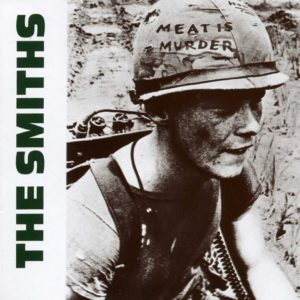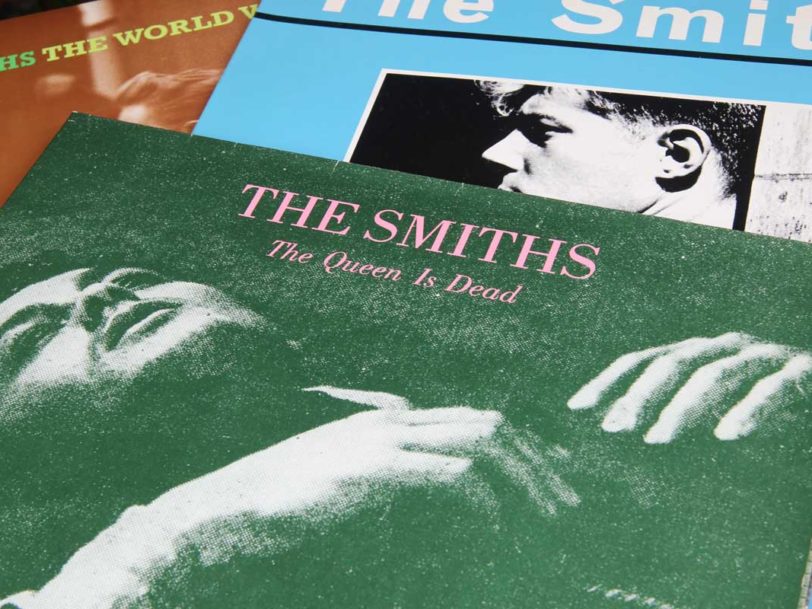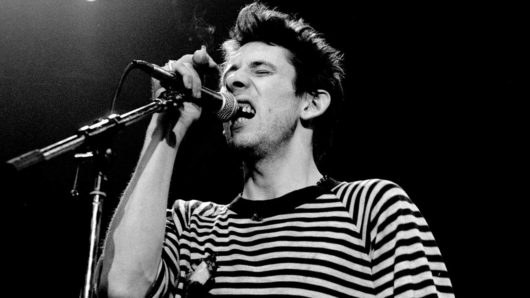The Smiths were arguably the most influential indie-pop outfit of all time, but their enduring appeal is further enhanced by the unique visual aesthetic they created through their record sleeves. Nearly always selected personally by Morrissey, The Smiths’ artworks largely eschewed pictures of the band and instead reflected the singer’s own formative influences, with classic images of soap opera stars or cult celluloid heroes from the 50s and 60s interspersed with the occasional trailblazing pop star.
Effectively the embodiment of “retro chic” long before the term was coined, the 27 black-and-white images (discreetly enhanced with colour where required) that graced the band’s album and single covers ensured that each of The Smiths’ releases was a special event in itself.
Here, then is every Smiths album and single cover, ranked and reviewed, revealing why The Smiths’ artworks retain their timeless allure.
The Smiths’ Album Covers, Ranked And Reviewed
8: ‘Strangeways, Here We Come’ (1987)
Morrissey’s admiration for the late James Dean led to the iconic film star adorning the cover of The Queen Is Dead’s lead single, Bigmouth Strikes Again. For The Smiths’ final album, Strangeways, Here We Come, however, Morrissey chose an (admittedly striking) image of Dean’s East Of Eden co-star, Richard Davalos, reputedly after his first choice, Harvey Keitel, turned him down.
Cover star: Richard Davalos (from the collection of David Loehr) | Designer: Morrissey | Art co-ordinator: Jo Slee | Layout: Caryn Gough
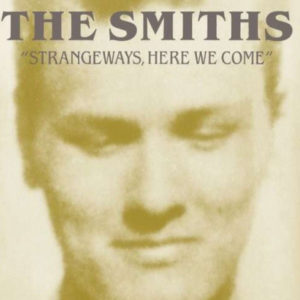
7: ‘Rank’ (1988)
Though released 12 months after The Smiths split, the posthumous live album Rank was a more than worthwhile addition to the band’s discography. Capturing them at the peak of their powers at London’s Kilburn National Ballroom on the The Queen Is Dead tour of 1986, it was issued in a lavish gatefold sleeve featuring an alluring photograph of Sussex-born actress Alexandra Bastedo, taken from John D Green’s Swinging London-era Birds Of Britain book. Bastedo is arguably best known for her role in the 1968 espionage/sci-fi series The Champions, though Morrissey reputedly chose her for the Rank album cover as she was also a committed vegetarian and an advocate for animal welfare – two issues especially dear to The Smiths’ frontman’s heart.
Cover star: Alexandro Bastedo | Photographer: John D Green Studios | Artwork: Jo Slee | Layout: Caryn Gough
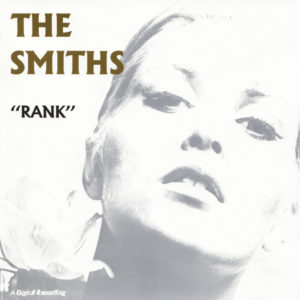
6: ‘The Smiths’ (1984)
The Smiths’ hotly-anticipated self-titled debut album arrived bearing an enigmatic image of late-60s heartthrob Joe Dallesandro. An Andy Warhol protégé, Dallesandro played a street hustler working on the streets of New York City in Warhol’s third film, Flesh (1968), directed by Paul Morrissey, and a heavily cropped still of the actor – taken from the film – graces The Smiths’ artwork. Dallesandro went on to star in several more Warhol movies, including Heat and the acclaimed Trash, and he also claimed to have been the model for The Rolling Stones’ Andy Warhol-designed Sticky Fingers album cover.
Cover star: Joe Dallesandro (still from Andy Warhol’s Flesh, directed by Paul Morrissey) | Sleeve design: Morrissey
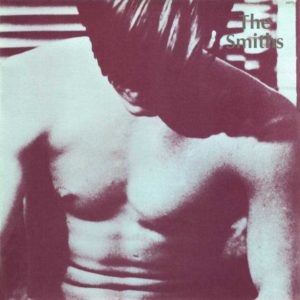
5: ‘Louder Than Bombs’ (1987)
Like James Dean, Shelagh Delaney was another of Morrissey’s most significant early influences, and the Salford-born dramatist looms large over The Smiths’ story. The band’s underrated early classic This Night Has Opened My Eyes (reprised on Louder Than Bombs) was broadly based upon the plot from Delaney’s 1958 play, A Taste Of Honey, which also provided the lines “I dreamt about you last night/And I fell out of bed twice” for The Smiths’ Reel Around The Fountain. A different image of Delaney also adorned the cover of the Girlfriend In A Coma single artwork, but the Louder Than Bombs image originally accompanied a feature in The Saturday Evening Post in October 1961.
Cover star: Shelagh Delaney | Sleeve design: Morrissey | Art direction: Jo Slee | Layout: Caryn Gough
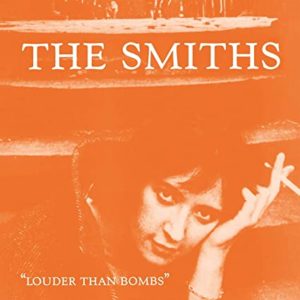
4: ‘Hatful Of Hollow’ (1984)
Adroitly bridging the gap between The Smiths and Meat Is Murder, Hatful Of Hollow comprised the best of The Smiths’ much-sought BBC Radio 1 session tracks, along with a smattering of standalone singles and B-sides, and soon established itself as an essential purchase in its own right. It was housed in an equally memorable sleeve featuring a profile shot of model Fabrice Colette sporting a tattoo inspired by a Jean Cocteau drawing. The original image was captured by French photographer Gilles Decroix, but when the sleeve was redesigned in 1987, the image was cropped and the tattoo was no longer visible.
Cover star: Fabrice Colette | Photographer: Gilles Decroix | Sleeve design: Morrissey | Layout: Caryn Gough
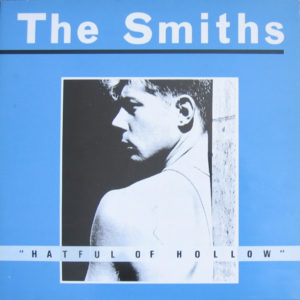
3: ‘The Queen Is Dead’ (1986)
Arguably The Smiths’ masterpiece, their third album, The Queen Is Dead, came packaged in a suitably regal gatefold sleeve, with an image of prominent French actor Alain Delon, from the 1964 noir thriller L’Insoumis (The Unvanquished), taking centre stage. It’s a great image in itself, but it’s photographer Stephen Wright’s iconic inner-sleeve shot of the band huddled outside the graffiti-splattered red brick walls of the Salford Lads’ Club that ensures The Queen Is Dead will always be right up there with the very best Smiths artworks.
Cover star: Alain Delon | Photographer: Stephen Wright | Sleeve design: Morrissey | Layout: Caryn Gough
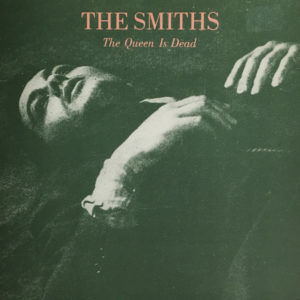
2: ‘The World Won’t Listen’ (1987)
First released in February 1987, The World Won’t Listen played a similar role to Hatful Of Hollow in that it collected most of The Smiths’ singles and B-sides from the previous 18 months, along with the previously unreleased song You Just Haven’t Earned It Yet, Baby. It’s still a great listen, and its Morrissey-designed cover was equally memorable, based upon a significantly cropped photograph taken by German photographer Jürgen Vollmer of a group of anonymous young men captured at a 50s fairground.
A close associate of The Beatles during their dues-paying stints playing the Hamburg clubs in the early 60s, Vollmer later published many of his most striking images from this period in 1983’s Rock’n’Roll Times: The Style And Spirit Of The Early Beatles And Their First Fans. Vollmer’s book also provided The World Won’t Listen’s rear artwork, depicting four girls at the same funfair bearing uncanny resemblances to The Smiths’ four members.
Cover stars: Anonymous teenagers at a funfair | Photographer: Jürgen Vollmer | Sleeve design: Morrissey | Art direction: Jo Slee | Layout: Caryn Gough
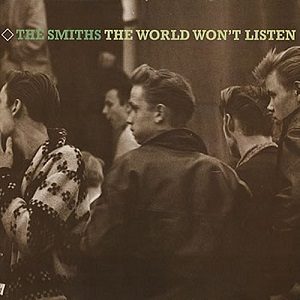
1: ‘Meat Is Murder’ (1985)
It’s up against stiff competition, but there’s something particularly stark and daring about album cover for the band’s second album, Meat Is Murder, which elevates it to the top of our list of The Smiths’ artworks. It’s an atypically direct artwork by Morrissey’s standards, but then he was making a heartfelt statement about his views on vegetarianism and the horrors of war, so it was fitting that he chose to use an image of US Marine Corporal Michael Wynn, from Emile De Antonio’s controversial Vietnam War documentary, In The Year Of The Pig. There was a further twist, though, for Morrissey replaced the slogan “Make Love Not War”, as scrawled on Wynn’s helmet in the original image, with The Smiths’ album title, instantly creating an iconic image of his own.
In an impassioned NME interview to accompany to album’s release in 1985, Morrissey said the album’s title was “a direct statement and it seems to me now that, as the front cover image of the LP hopefully illustrates, the only way we can get rid of such things as the meat industry, and other things like nuclear weapons, is by really giving people a taste of their own medicine”.
Cover star: US Marine Corporal Michael Wynn (still from Emile De Antonio’s In The Year Of The Pig) | Sleeve design: Morrissey | Layout: Caryn Gough
